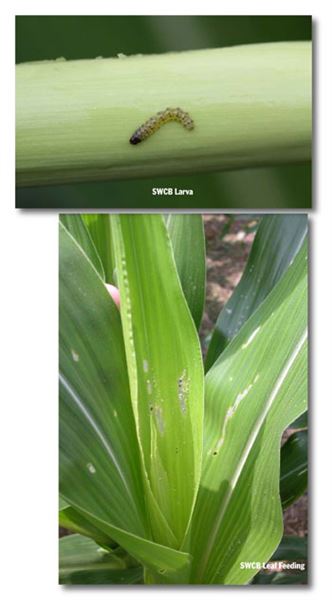Scouting For Southwestern Corn Borers
JACKSON, TENN.
Given the high moth
catches in pheromone
traps, particularly in the
West Tennessee counties bordering
Kentucky, there are
certainly some non-Bt corn
fields that are (or will be) infested
with damaging populations
of
southwestern corn borer
(SWCB). You will sometimes
hear not to worry about first
generation infestations, and it
is the second generation that
does the most damage. This is
kind of true only because the
second generation is typically
larger and more spread out.
However, first generation infestations
of SWCB in whorl
stage corn can be even more
impactful on yield.
The treatment threshold for
SWCB is when 20 percent or
more of plants are infested,
and honestly, I think 15 percent
is a better number.
Scouting and treatment for
SWCB is much easier during
the whorl stage. I do not scout for SWCB
eggs during the whorl stage. It takes too
much time, and larvae are much easier
to detect. Larvae feed in whorls almost
exclusively until they begin to tunnel
into stalks 7-10 days after hatching.
Leaf feeding will be apparent as whorl
leaves emerge. Typical signs include
elongate or irregular holes on leaves and
a windowpaning effect. The whorls of
damaged plants can be pulled out and
unrolled to confirm the presence of larvae
(also pictured below). Small SWCB
larvae are white to pale yellow, have a
dark head capsule, and rows of dark
spots that get more conspicuous as they
grow. Frankly, you can just walk
through fields and move on if you are
not seeing any signs of feeding on
emerging whorl leaves.

Fall armyworm or corn earworm larvae
may also feed in whorls. If in doubt, get
some help to make sure you can tell the
difference.
Insecticide applications, if justified,
should be made before most larvae have
begun tunneling or they will be much
less effective. It is not impossible that
two applications will be needed if infestations
persist. My preferred treatment
in whorl stage corn is mid-range or
higher rates of pyrethroid insecticides
such as Asana XL, Baythroid XL, Declare,
Karate, Mustang Max or one of the
bifenthrin products. The pyrethroids
typically work well in whorl stage corn and are
economical. In contrast, products such as Intrepid,
Belt SC or Prevathon are preferred treatments
for infestations in tasseling corn.
Do you have a problem of SWCB on your
farm? I could give you a pretty good guess based
on pheromone traps catches on your farm. Otherwise,
it requires scouting. Δ
DR. SCOTT STEWART: IPM Extension Specialist,
University of Tennessee